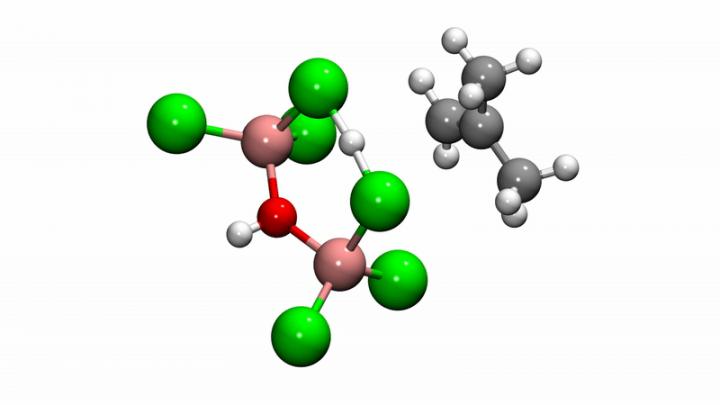Computing catalysts

Reaction mechanism showing a proton transfer from the superacid catalyst to isobutylene. This is the first step in the PIB polymerization process. Credit: Minh Nguyen Vo/Johnson Research Group
Polyisobutylene (PIB) is a workhorse polymer that is found in a multitude of products, ranging from chewing gum, to tires, to engine oil and gasoline additives. Although commercially produced in large quantities since the 1940s, PIB chemistry was a mystery – scientists weren't sure how the reaction mechanism that creates the polymer happens at the molecular level, which limited further potential.
However, a collaboration between the University of Pittsburgh's Swanson School of Engineering and Wickliffe, Ohio-based Lubrizol Corporation has unlocked the secrets of PIB's reaction mechanism. The group's findings were published this month in the journal ACS Catalysis (DOI: 10.1021/acscatal.8b01494).
Principal investigator is Karl Johnson, the William Kepler Whiteford Professor in the Swanson School's Department of Chemical & Petroleum Engineering. Funding for the research was provided by Lubrizol, which in 2014 established a $1.2 million strategic partnership with the Department and Swanson School to jumpstart research innovation that also offers opportunities for undergraduates to participate.
“PIB is an incredibly versatile polymer. It can have many different properties depending on how it is made. There are many different 'recipes' for making PIB, each employing different catalysts and reaction conditions, but it turns out that no one really knows what is happening at the molecular level. Finding out what is going on is important because it is harder to control a process that you don't understand.”
Solving this catalytic puzzle is of interest to Lubrizol, which specializes in ingredients and additives for polymer-based products. Utilizing the University's Center for Research Computing to analyze the molecular processes, the Pitt/Lubrizol group found that the assumed reaction mechanism was not correct and that initiation of the reaction requires a “superacid” catalyst.
“These findings provide fundamental insight into the PIB reaction mechanism that could potentially be used to design different catalysts and to control the reaction – and hence, the potential range of products – in ways that are currently not possible.” Dr. Johnson said. “This project shows the value of creating academic/industrial partnerships to pursue research that might not be possible if pursued independently.”
###
The research group included students Yasemin Basdogan, Bridget S. Derksen, and Minh Nguyen Vo; Assistant Professor John A. Keith, the R.K. Mellon Faculty Fellow in Energy; and Lubrizol researchers Adam Cox, research chemist, Cliff Kowall, technical fellow of process development, and Nico Proust, R&D technology manager.
Media Contact
All latest news from the category: Physics and Astronomy
This area deals with the fundamental laws and building blocks of nature and how they interact, the properties and the behavior of matter, and research into space and time and their structures.
innovations-report provides in-depth reports and articles on subjects such as astrophysics, laser technologies, nuclear, quantum, particle and solid-state physics, nanotechnologies, planetary research and findings (Mars, Venus) and developments related to the Hubble Telescope.
Newest articles

Webb captures top of iconic horsehead nebula in unprecedented detail
NASA’s James Webb Space Telescope has captured the sharpest infrared images to date of a zoomed-in portion of one of the most distinctive objects in our skies, the Horsehead Nebula….

Cost-effective, high-capacity, and cyclable lithium-ion battery cathodes
Charge-recharge cycling of lithium-superrich iron oxide, a cost-effective and high-capacity cathode for new-generation lithium-ion batteries, can be greatly improved by doping with readily available mineral elements. The energy capacity and…

Novel genetic plant regeneration approach
…without the application of phytohormones. Researchers develop a novel plant regeneration approach by modulating the expression of genes that control plant cell differentiation. For ages now, plants have been the…





















